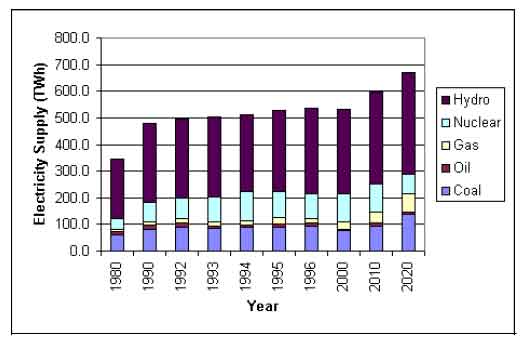
Questions 21 – 25 are based on the passage and graph below.
Hydroelectric power is a timeless, renewable resource that fuelled Ontario's economic growth in the first half of the twentieth century.
Hydroelectric power plants convert the kinetic energy contained in falling water into electricity. Most hydroelectric stations use either the natural "drop" of the river or build a dam across the river to raise the water level and provide the drop needed to create a driving force. Water at the higher level (the forebay) goes through the intake into a pipe, called a penstock, which carries it down to the turbine.
The turbine is connected to a generator. When the turbine is set in motion, it causes the generator to rotate, and electricity is produced. The falling water, having served its purpose, exits the generating station through the draft tube and the tailrace where it rejoins the main stream of the river.
Hydroelectric plants have long been considered a clean and environmentally safe method of producing electricity. Hydro plants do not emit any of the standard atmospheric pollutants such as carbon dioxide or sulphur dioxide that fossil fuel burning power plants do. Hydro plants also avoid the risk of radioactive contamination that is associated with nuclear power plants.
On the other hand, hydroelectric power has been associated with several environmental problems:
Canada’s production of hydroelectricity began in the late 1880’s following the invention of the electric motor. The abundant supply of water made hydroelectricity popular source of power. By 1920, more than 97% of the total electricity produced in Canada came from hydroelectric plants. Today, hydroelectric power is the largest domestic source of electric energy, representing 61% of the nation’s supply in 1997.